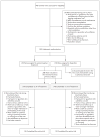Acetaminophen versus Ibuprofen in Young Children with Mild Persistent Asthma
- PMID: 27532828
- PMCID: PMC5085065
- DOI: 10.1056/NEJMoa1515990
Acetaminophen versus Ibuprofen in Young Children with Mild Persistent Asthma
Abstract
Background: Studies have suggested an association between frequent acetaminophen use and asthma-related complications among children, leading some physicians to recommend that acetaminophen be avoided in children with asthma; however, appropriately designed trials evaluating this association in children are lacking.
Methods: In a multicenter, prospective, randomized, double-blind, parallel-group trial, we enrolled 300 children (age range, 12 to 59 months) with mild persistent asthma and assigned them to receive either acetaminophen or ibuprofen when needed for the alleviation of fever or pain over the course of 48 weeks. The primary outcome was the number of asthma exacerbations that led to treatment with systemic glucocorticoids. Children in both groups received standardized asthma-controller therapies that were used in a simultaneous, factorially linked trial.
Results: Participants received a median of 5.5 doses (interquartile range, 1.0 to 15.0) of trial medication; there was no significant between-group difference in the median number of doses received (P=0.47). The number of asthma exacerbations did not differ significantly between the two groups, with a mean of 0.81 per participant with acetaminophen and 0.87 per participant with ibuprofen over 46 weeks of follow-up (relative rate of asthma exacerbations in the acetaminophen group vs. the ibuprofen group, 0.94; 95% confidence interval, 0.69 to 1.28; P=0.67). In the acetaminophen group, 49% of participants had at least one asthma exacerbation and 21% had at least two, as compared with 47% and 24%, respectively, in the ibuprofen group. Similarly, no significant differences were detected between acetaminophen and ibuprofen with respect to the percentage of asthma-control days (85.8% and 86.8%, respectively; P=0.50), use of an albuterol rescue inhaler (2.8 and 3.0 inhalations per week, respectively; P=0.69), unscheduled health care utilization for asthma (0.75 and 0.76 episodes per participant, respectively; P=0.94), or adverse events.
Conclusions: Among young children with mild persistent asthma, as-needed use of acetaminophen was not shown to be associated with a higher incidence of asthma exacerbations or worse asthma control than was as-needed use of ibuprofen. (Funded by the National Institutes of Health; AVICA ClinicalTrials.gov number, NCT01606319.).
Figures



Comment in
-
Acetaminophen and Asthma--A Small Sigh of Relief?N Engl J Med. 2016 Aug 18;375(7):684-5. doi: 10.1056/NEJMe1607629. N Engl J Med. 2016. PMID: 27532835 No abstract available.
-
Paracetamol is no more likely to exacerbate asthma in children than ibuprofen, shows study.BMJ. 2016 Aug 17;354:i4558. doi: 10.1136/bmj.i4558. BMJ. 2016. PMID: 27540037 No abstract available.
-
Acetaminophen versus Ibuprofen in Mild Persistent Asthma.N Engl J Med. 2016 Nov 24;375(21):2099-100. doi: 10.1056/NEJMc1612164. N Engl J Med. 2016. PMID: 27959729 Free PMC article. No abstract available.
-
Acetaminophen versus Ibuprofen in Mild Persistent Asthma.N Engl J Med. 2016 Nov 24;375(21):2099. doi: 10.1056/NEJMc1612164. N Engl J Med. 2016. PMID: 27959730 No abstract available.
-
Risk Factors Associated with Asthma Development and Control in Children. Mouse Infestation, Antipyretics, Respiratory Viruses, and Allergic Sensitization.Am J Respir Crit Care Med. 2017 Dec 15;196(12):1605-1607. doi: 10.1164/rccm.201704-0696RR. Am J Respir Crit Care Med. 2017. PMID: 29064272 Free PMC article. No abstract available.
References
-
- Vernacchio L, Kelly JP, Kaufman DW, Mitchell AA. Medication use among children <12 years of age in the United States: results from the Slone Survey. Pediatrics. 2009;124:446–54. - PubMed
-
- Beasley R, Clayton T, Crane J, et al. Association between paracetamol use in infancy and childhood, and risk of asthma, rhinoconjunctivitis, and eczema in children aged 6–7 years: analysis from Phase Three of the ISAAC programme. Lancet. 2008;372:1039–48. - PubMed
-
- Beasley RW, Clayton TO, Crane J, et al. Acetaminophen use and risk of asthma, rhinoconjunctivitis, and eczema in adolescents: International Study of Asthma and Allergies in Childhood Phase Three. Am J Respir Crit Care Med. 2011;183:171–8. - PubMed
-
- Davey G, Berhane Y, Duncan P, Aref-Adib G, Britton J, Venn A. Use of acetaminophen and the risk of self-reported allergic symptoms and skin sensitization in Butajira, Ethiopia. J Allergy Clin Immunol. 2005;116:863–8. - PubMed
-
- Wickens K, Beasley R, Town I, et al. The effects of early and late paracetamol exposure on asthma and atopy: a birth cohort. Clin Exp Allergy. 2011;41:399–406. - PubMed
Publication types
MeSH terms
Substances
Associated data
Grants and funding
- HL098075/HL/NHLBI NIH HHS/United States
- U10 HL098107/HL/NHLBI NIH HHS/United States
- U10 HL098075/HL/NHLBI NIH HHS/United States
- HL098103/HL/NHLBI NIH HHS/United States
- K23 AI104780/AI/NIAID NIH HHS/United States
- K23 AI106945/AI/NIAID NIH HHS/United States
- L40 AI107923/AI/NIAID NIH HHS/United States
- U10 HL098096/HL/NHLBI NIH HHS/United States
- U10 HL098102/HL/NHLBI NIH HHS/United States
- U10 HL098115/HL/NHLBI NIH HHS/United States
- U10 HL098177/HL/NHLBI NIH HHS/United States
- K23AI104780/AI/NIAID NIH HHS/United States
- HL098098/HL/NHLBI NIH HHS/United States
- HL098115/HL/NHLBI NIH HHS/United States
- HL098090/HL/NHLBI NIH HHS/United States
- HL098102/HL/NHLBI NIH HHS/United States
- UL1 TR000439/TR/NCATS NIH HHS/United States
- TR001082/TR/NCATS NIH HHS/United States
- UL1 TR000454/TR/NCATS NIH HHS/United States
- U10 HL098103/HL/NHLBI NIH HHS/United States
- HL098177/HL/NHLBI NIH HHS/United States
- UL1 TR000448/TR/NCATS NIH HHS/United States
- TR000454/TR/NCATS NIH HHS/United States
- UL1 TR001082/TR/NCATS NIH HHS/United States
- UL1 TR001102/TR/NCATS NIH HHS/United States
- HL098112/HL/NHLBI NIH HHS/United States
- TR000448/TR/NCATS NIH HHS/United States
- U10 HL098090/HL/NHLBI NIH HHS/United States
- U10 HL098112/HL/NHLBI NIH HHS/United States
- K24AI106822/AI/NIAID NIH HHS/United States
- HL098107/HL/NHLBI NIH HHS/United States
- U10 HL098098/HL/NHLBI NIH HHS/United States
- TR000439/TR/NCATS NIH HHS/United States
- HL098096/HL/NHLBI NIH HHS/United States
- U10 HL064313/HL/NHLBI NIH HHS/United States
- K24 AI106822/AI/NIAID NIH HHS/United States
LinkOut - more resources
Full Text Sources
Other Literature Sources
Medical
